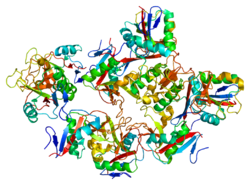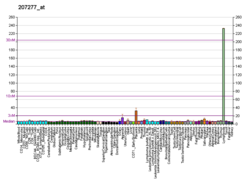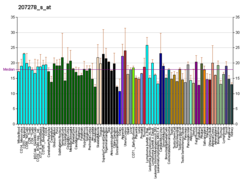DC-SIGN (Dendritic Cell-Specific Intercellular adhesion molecule-3-Grabbing Non-integrin) also known as CD209 (Cluster of Differentiation 209) is a protein which in humans is encoded by the CD209 gene.
DC-SIGN is a C-type lectin receptor present on the surface of both macrophages and dendritic cells. DC-SIGN on macrophages recognises and binds with high affinity to high-mannose type N-glycans, a class of PAMPs (pathogen associated molecular patterns) commonly found on viruses, bacteria and fungi. This binding interaction activates phagocytosis. On myeloid and pre-plasmacytoid dendritic cells DC-SIGN mediates dendritic cell rolling interactions with blood endothelium and activation of CD4+ T cells, as well as recognition of pathogen haptens.
Function
DC-SIGN is a C-type lectin and has a high affinity for the ICAM3 molecule. It binds various microorganisms by recognizing high-mannose-containing glycoproteins on their surface, and can function as a co-receptor for several viruses such as HIV and Hepatitis C. Binding to DC-SIGN can promote HIV and Hepatitis C virus to infect target cells (T-cells and hepatocytes, respectively).
Besides functioning as an adhesion molecule, recent studies have also shown that DC-SIGN can initiate innate immunity by modulating toll-like receptors, though the detailed mechanism is not yet known. DC-SIGN together with other C-type lectins is involved in recognition of tumors by dendritic cells. DC-SIGN is also a potential engineering target for dendritic cell based cancer vaccine.
Clinical significance
HIV infection
This molecule is involved in the initial stages of the human immunodeficiency virus infection, as the HIV gp120 molecule causes co-internalization of the DC-SIGN molecule and HIV virus particle (virion). The dendritic cell then migrates to the cognate lymphoid organ, whereupon recycling of the DC-SIGN/HIV virion complex to the cell periphery facilitates HIV infection of CD4 T cells by interaction between DC-SIGN and ICAM-3.
Ebola infection
Different studies have demonstrated that the ebola virus infection process starts when the virus reaches the cellular DC-SIGN receptor to infect the dendritic cells (of the immune system). In 2015 European researchers designed a “giant” molecule formed by thirteen fullerenes covered by carbohydrates which, by blocking DC-SIGN receptor, are able to inhibit the cell infection by an artificial ebola virus model. These antiviral molecules decorated with specific carbohydrates (sugars) present affinity by the receptor used as an entry point to infect the cell and act blocking it, thus inhibiting the infection in a sub-nanomolar range.
SARS-CoV-2
Similarly to HIV-1 gp120 binding, both DC-SIGN and its homologue L-SIGN (CD209L or CD299) have also been identified as receptors facilitating the entry of Severe acute respiratory syndrome coronavirus 2 (SARS-CoV-2) into human cells. Significant CD209L expression has been revealed in lung and kidney epithelia and endothelia and interactions with SARS-CoV-2 Spike protein (S protein) have been demonstrated in vitro. CD209L also exhibits interaction with Angiotensin-converting enzyme-2 (ACE2), suggesting a potential role for CD209L-ACE2 heterodimerization in SARS-CoV-2 entry and infection in cell types expressing both proteins. It is shown that DC/L-SIGN can enhance viral infection and dissemination by contributing to additional routes of infection mediated by the S protein in a process called trans-infection. This process seems to be exclusive for DC/L-SIGN interaction. This complexity in the recognition patterns and functions of these C-lectin receptors is similar to what has been described for other viruses (like HIV and Ebola virus) and thus both DC/L-SIGN are considered as pattern recognition receptors (PRR).
Gene family
DC-SIGN/CD209 is an animal "C-lectin", a large and diverse family of proteins found in both prokaryotes and eukaryotes most of which are functional lectins, meaning they bind carbohydrate ligands, and whose ligand-binding affinity requires calcium (hence "C-lectin"). Among the animal C-lectins, a subfamily known as the ASGR (asialoglycoprotein receptors) group contains several sub-sub-families, many of which are important to innate immunity.
A cluster of genes in both humans and mice contains three related members of the "DC Receptor" class, so named because of their homology to DC-SIGN. Of these, CD23 is, however, not expressed on dendritic cells but is a characteristic surface molecule of B lymphocytes, and LSectin (CLEC4G) is expressed on the sinusoidal endothelium of the liver. The third gene group consists of multiple paralogues of CD209. Thus, both primates and mice have multiple paralogues of CD209 more closely related to each other within the species than to their orthologous counterparts in the other species. Higher primates have at least three DC-SIGN genes, DC-SIGN, DC-SIGNL1 (also known as DC-SIGNR or L-SIGN) and DC-SIGNL2, although not all three are present in every species; DC-SIGNL2 has not been detected in humans. Eight paralogous of DC-SIGN have been reported in the laboratory mouse strain C57BL/6; these go by the names DC-SIGN, DC-SIGNR2...DC-SIGNR8. DC-SIGNR6 is a pseudogene. The genes labeled "DC-SIGN" in the human and mouse are thus not unique orthologues, although they resemble each other functionally and by being expressed on dendritic cells. Other members of the mouse CD209 gene group are differentially expressed on different cell types. For example, DC-SIGNR1 is expressed largely on macrophages in the marginal zones of the spleen and in the medulla of lymph nodes.
References
- ^ GRCh38: Ensembl release 89: ENSG00000090659 – Ensembl, May 2017
- ^ GRCm38: Ensembl release 89: ENSMUSG00000040197 – Ensembl, May 2017
- "Human PubMed Reference:". National Center for Biotechnology Information, U.S. National Library of Medicine.
- "Mouse PubMed Reference:". National Center for Biotechnology Information, U.S. National Library of Medicine.
- Curtis BM, Scharnowske S, Watson AJ (September 1992). "Sequence and expression of a membrane-associated C-type lectin that exhibits CD4-independent binding of human immunodeficiency virus envelope glycoprotein gp120". Proceedings of the National Academy of Sciences of the United States of America. 89 (17): 8356–8360. Bibcode:1992PNAS...89.8356C. doi:10.1073/pnas.89.17.8356. PMC 49917. PMID 1518869.
- McGreal EP, Miller JL, Gordon S (February 2005). "Ligand recognition by antigen-presenting cell C-type lectin receptors". Current Opinion in Immunology. 17 (1): 18–24. doi:10.1016/j.coi.2004.12.001. PMC 7126011. PMID 15653305.
- Khoo US, Chan KY, Chan VS, Lin CL (August 2008). "DC-SIGN and L-SIGN: the SIGNs for infection". Journal of Molecular Medicine. 86 (8): 861–874. doi:10.1007/s00109-008-0350-2. PMC 7079906. PMID 18458800.
- Lozach PY, Burleigh L, Staropoli I, Amara A (2007). "The C Type Lectins DC-SIGN and L-SIGN". Glycovirology Protocols. Methods in Molecular Biology. Vol. 379. pp. 51–68. doi:10.1007/978-1-59745-393-6_4. ISBN 978-1-58829-590-3. PMC 7122727. PMID 17502670.
- ^ Lozach PY, Amara A, Bartosch B, Virelizier JL, Arenzana-Seisdedos F, Cosset FL, Altmeyer R (July 2004). "C-type lectins L-SIGN and DC-SIGN capture and transmit infectious hepatitis C virus pseudotype particles". The Journal of Biological Chemistry. 279 (31): 32035–32045. doi:10.1074/jbc.M402296200. PMID 15166245.
- ^ Geijtenbeek TB, Kwon DS, Torensma R, van Vliet SJ, van Duijnhoven GC, Middel J, et al. (March 2000). "DC-SIGN, a dendritic cell-specific HIV-1-binding protein that enhances trans-infection of T cells". Cell. 100 (5): 587–597. doi:10.1016/S0092-8674(00)80694-7. PMID 10721995. S2CID 15041781.
- den Dunnen J, Gringhuis SI, Geijtenbeek TB (July 2009). "Innate signaling by the C-type lectin DC-SIGN dictates immune responses". Cancer Immunology, Immunotherapy. 58 (7): 1149–1157. doi:10.1007/s00262-008-0615-1. PMC 11030075. PMID 18998127.
- Aarnoudse CA, Garcia Vallejo JJ, Saeland E, van Kooyk Y (February 2006). "Recognition of tumor glycans by antigen-presenting cells". Current Opinion in Immunology. 18 (1): 105–111. doi:10.1016/j.coi.2005.11.001. PMID 16303292.
- van den Berg LM, Geijtenbeek TB (2012). "Antiviral Immune Responses by Human Langerhans Cells and Dendritic Cells in HIV-1 Infection". HIV Interactions with Dendritic Cells. Advances in Experimental Medicine and Biology. Vol. 762. pp. 45–70. doi:10.1007/978-1-4614-4433-6_2. ISBN 978-1-4614-4432-9. PMID 22975871.
- Muñoz A, Sigwalt D, Illescas BM, Luczkowiak J, Rodríguez-Pérez L, Nierengarten I, et al. (January 2016). "Synthesis of giant globular multivalent glycofullerenes as potent inhibitors in a model of Ebola virus infection". Nature Chemistry. 8 (1): 50–57. Bibcode:2016NatCh...8...50M. doi:10.1038/nchem.2387. hdl:10261/127820. PMID 27055288.
- Florian A L, Leah B S, Martin MR, et al. (October 2021). "Lectins enhance SARS-CoV-2 infection and influence neutralizing antibodies". Nature. 598 (7880). doi:10.1038/s41586-021-03925-1. ISSN 1476-4687. PMID 34464958.
- Rahimi N (December 2020). "C-type Lectin CD209L/L-SIGN and CD209/DC-SIGN: Cell Adhesion Molecules Turned to Pathogen Recognition Receptors". Biology. 10 (1): 1. doi:10.3390/biology10010001. PMC 7822156. PMID 33375175.
- Gao C, Zeng J, Jia N, Stavenhagen K, Matsumoto Y, Zhang H, Li J, Hume AJ, Mühlberger E (2020-07-30). SARS-CoV-2 Spike Protein Interacts with Multiple Innate Immune Receptors (Report). Biochemistry. doi:10.1101/2020.07.29.227462. PMC 7402034. PMID 32766577.
- Amraei R, Yin W, Napoleon MA, Suder EL, Berrigan J, Zhao Q, et al. (July 2021). "CD209L/L-SIGN and CD209/DC-SIGN Act as Receptors for SARS-CoV-2". ACS Central Science. 7 (7): 1156–1165. doi:10.1021/acscentsci.0c01537. PMC 8265543. PMID 34341769.
- Thépaut M, Luczkowiak J, Vivès C, Labiod N, Bally I, Lasala F, et al. (May 2021). Pekosz A (ed.). "DC/L-SIGN recognition of spike glycoprotein promotes SARS-CoV-2 trans-infection and can be inhibited by a glycomimetic antagonist". PLOS Pathogens. 17 (5): e1009576. doi:10.1371/journal.ppat.1009576. PMC 8136665. PMID 34015061.
- Davis CW, Nguyen HY, Hanna SL, Sánchez MD, Doms RW, Pierson TC (2006). "West Nile Virus Discriminates between DC-SIGN and DC-SIGNR for Cellular Attachment and Infection". Journal of Virology. 80 (3): 1290–1301. doi:10.1128/JVI.80.3.1290-1301.2006. PMC 1346927. PMID 16415006.
- Ortiz M, Kaessmann H, Zhang K, Bashirova A, Carrington M, Quintana-Murci L, Telenti A (September 2008). "The evolutionary history of the CD209 (DC-SIGN) family in humans and non-human primates". Genes and Immunity. 9 (6): 483–492. doi:10.1038/gene.2008.40. PMC 2701223. PMID 18528403.
Further reading
- Geijtenbeek TB, Engering A, Van Kooyk Y (June 2002). "DC-SIGN, a C-type lectin on dendritic cells that unveils many aspects of dendritic cell biology". Journal of Leukocyte Biology. 71 (6): 921–931. doi:10.1189/jlb.71.6.921. PMID 12050176. S2CID 42418837.
- Baribaud F, Doms RW, Pöhlmann S (August 2002). "The role of DC-SIGN and DC-SIGNR in HIV and Ebola virus infection: can potential therapeutics block virus transmission and dissemination?". Expert Opinion on Therapeutic Targets. 6 (4): 423–431. doi:10.1517/14728222.6.4.423. PMID 12223058. S2CID 21541850.
- Bénichou S, Benmerah A (January 2003). "[The HIV nef and the Kaposi-sarcoma-associated virus K3/K5 proteins: "parasites"of the endocytosis pathway]". Médecine/Sciences. 19 (1): 100–106. doi:10.1051/medsci/2003191100. PMID 12836198.
- van Kooyk Y, Geijtenbeek TB (September 2003). "DC-SIGN: escape mechanism for pathogens". Nature Reviews. Immunology. 3 (9): 697–709. doi:10.1038/nri1182. PMID 12949494. S2CID 13547669.
- Turville S, Wilkinson J, Cameron P, Dable J, Cunningham AL (November 2003). "The role of dendritic cell C-type lectin receptors in HIV pathogenesis". Journal of Leukocyte Biology. 74 (5): 710–718. doi:10.1189/jlb.0503208. PMID 12960229. S2CID 44539239.
- Cambi A, Figdor CG (October 2003). "Dual function of C-type lectin-like receptors in the immune system". Current Opinion in Cell Biology. 15 (5): 539–546. doi:10.1016/j.ceb.2003.08.004. PMID 14519388.
- Joseph AM, Kumar M, Mitra D (January 2005). "Nef: "necessary and enforcing factor" in HIV infection". Current HIV Research. 3 (1): 87–94. doi:10.2174/1570162052773013. PMID 15638726.
- Stove V, Verhasselt B (January 2006). "Modelling thymic HIV-1 Nef effects". Current HIV Research. 4 (1): 57–64. doi:10.2174/157016206775197583. PMID 16454711.
- Ortiz M, Kaessmann H, Zhang K, Bashirova A, Carrington M, Quintana-Murci L, Telenti A (September 2008). "The evolutionary history of the CD209 (DC-SIGN) family in humans and non-human primates". Genes and Immunity. 9 (6): 483–492. doi:10.1038/gene.2008.40. PMC 2701223. PMID 18528403.
- Becer CR, Gibson MI, Geng J, Ilyas R, Wallis R, Mitchell DA, Haddleton DM (November 2010). "High-affinity glycopolymer binding to human DC-SIGN and disruption of DC-SIGN interactions with HIV envelope glycoprotein". Journal of the American Chemical Society. 132 (43): 15130–15132. doi:10.1021/ja1056714. PMC 3091610. PMID 20932025.
External links
- DC-SIGN at the U.S. National Library of Medicine Medical Subject Headings (MeSH)
| PDB gallery | |
|---|---|
|
| Proteins: clusters of differentiation (see also list of human clusters of differentiation) | |
|---|---|
| 1–50 | |
| 51–100 | |
| 101–150 | |
| 151–200 | |
| 201–250 | |
| 251–300 | |
| 301–350 | |
This article incorporates text from the United States National Library of Medicine, which is in the public domain.
Categories:










